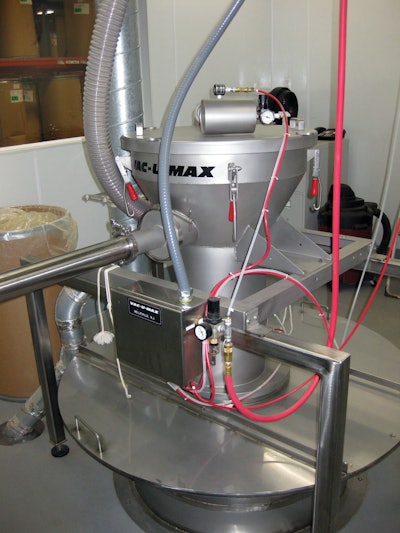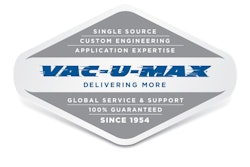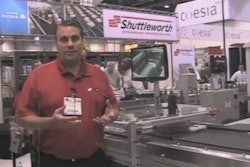Located in Sebastopol, CA, tea marketer Traditional Medicinals operates 20 hr daily, four days/week to produce 2 million teabags per week. Raw materials are brought in from around the world in already tea cut form, reinspected, and repackaged into barrel containers to feed into the blenders via a hopper system. Once the formulas are blended, they are transferred to the packaging area where they are gravity fed from a mezzanine level to machines from IMA (www.ima.it) that process between 135 and 185 teabags per minute.
While working on a major efficiency project that culminated in the building of new rooms for the blending area, management decided that it was time to, in the words of plant manager Mary Goff, “cut down the amount of lifting that the operators were doing manually in our production department.” Previously, the operators were weighing individual hundred-pound batches into barrels, taking those barrels up to the top level, and then dumping them into hoppers manually by hand. In search of a better method, Goff and colleagues researched open conveyor systems as an ergonomic solution for transferring the raw materials. Whatever system they were going to consider had to be not only efficient but also gentle on the product being handled. That’s because Traditional Medicinals uses pharmacopoeial grade herbs, and one of its biggest concerns was how to transfer the herbs and blends from one area to another without breaking down the product or losing any of it.
“We did a lot of studies up front,” says Goff of choosing the right systems to transfer ingredients. “We spoke with some of our raw materials vendors about the systems they used to transfer materials, and a gentleman from the consulting firm we were working with on the efficiency project told us about Vac-U-Max.”
A pioneer in vacuum pneumatic conveying, Vac-U-Max (www.vac-u-max.com) specializes in the design and manufacture of pneumatic systems and support equipment for the conveying, weighing, and batching of dry materials in the pharmaceutical, chemical, and food industries. Although the company’s herb suppliers warned against pneumatically conveying the herbs—thinking that it would damage the ingredients—the information Goff pulled from the conveyor manufacturer’s website convinced her and her team that the method was worthy of investigation.
Pneumatic conveying systems, they felt, have certain advantages over open conveying systems such as belt or bucket conveyors. Ease of cleaning and the smaller footprint of pneumatic conveying systems are two of such advantages.
In addition, pneumatic conveying systems are fully enclosed, protecting materials from air, dirt, and waste. Because product does not escape from a pneumatic conveying system, particulates that can endanger or jam expensive equipment are prevented from entering the environment.
Although the advantages of the pneumatic system in theory seemed to outweigh the open systems, Traditional Medicinals needed assurance that the vacuum system would perform reliably without breaking down the product.
Try before you buy
“If the product is too fine it creates problems with separation and blending and also creates problems with packaging if it is too dusty,” says Goff. “Before purchasing the equipment, we wanted to be sure that it could transfer the product correctly, and that the product was holding its integrity from a quality standpoint.”
Vac-u-Max offers testing at no charge to potential customers in their fully functional state-of-the-art 6,000 sq ft test and demonstration facility, which is equipped to conduct a number of vacuum conveying tests to simulate the actual conditions at a customer’s site. After consultation with the company to arrive at system design and equipment specifications, Goff and colleagues traveled to New Jersey to test the equipment with 15 of the company’s raw materials. “We spent a whole morning with Vac-u-Max running through the testing making sure that we were happy with their equipment,” says Goff.
“One of our biggest concerns,” she adds, “was the breakdown of the materials themselves, and that’s one of the negatives that we kept hearing from our herb suppliers, but Vac-U-Max assured us that it wouldn’t. And they’ve proven that it is a very gentle way to move product,” says Goff.
During the testing, it was determined that the three-filter system initially specified for the application was capturing more product than desired, so Vac-U-Max came up with a single-system filter instead and adjusted the flow rate. “We were able to get it to the point that we were satisfied with it without much effort at all.”
Because Traditional Medicinals runs between three and four blends per day in the department, the conveyor manufacturer set the company up with a cloth-type cleanable filter that is able to be cleaned, sanitized, and reused. The company has several filters on hand for each blend.
When the new blending area was finished, the Vac-U-Max system was implemented into the new process where raw materials are brought in and taken to a second level where they are run through magnets and then scaled into a barrel. The pneumatic conveyor system transfers the product back up to another room where the system performs as the hopper feed for the blender itself. Now rather than operators using forklifts to bring barrels up to the mezzanine level, and manually scooping materials into the hopper, operators insert a wand into the barrels and product is pneumatically transferred from the wand to the blenders.
“The system has eliminated all the forklift traffic, and from an ergonomic standpoint it’s saving a lot of wear and tear on our blenders’ backs,” says Goff. In addition to creating a better ergonomic environment for the operators, Goff says “The whole system is more efficient too, and we are really happy with that side of it. I’m predicting that we’ll be able to improve capacity by 20 percent.”
Cleaning and maintenance
When running three or four blends a day, ease of cleaning quickly becomes an efficiency point when sanitation between runs is required. For this application, the Vac-U-Max system has a food-grade polished surface for effortless cleaning and product flow. In addition, all systems are equipped with heavy-duty clamps that enable quick disassemble without tools.
“It’s very easy to take it apart,” says Goff. “We do it three to four times a day, and we change the filter between each blend.” All of which makes her a satisfied customer.
“With the pneumatic system transferring the materials, it’s a lot quicker, and we expect that it will work well when we bring in a higher capacity machine later this year.”


























